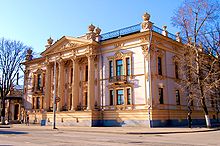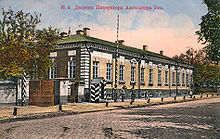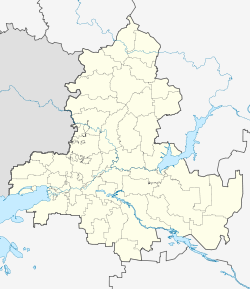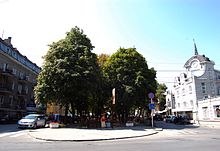Taganrog
| city
Taganrog
Таганрог
|
||||||||||||||||||||||||||||||||||||||||||
|
||||||||||||||||||||||||||||||||||||||||||
|
||||||||||||||||||||||||||||||||||||||||||
| List of cities in Russia | ||||||||||||||||||||||||||||||||||||||||||
Taganrog ( Russian Таганро́г , Ukrainian Tahanroh or rarely Таганріг / Tahanrih ) is a port city in southern Russia on the coast of the Sea of Azov at the mouth of the Don with 257,681 inhabitants (as of October 14, 2010). It is located in the Rostov Oblast and is the second largest city in this region after Rostov-on-Don .
location
Taganrog is located on the north shore of the Sea of Azov, about 80 kilometers west of the regional capital Rostov in the southwestern part of the Rostov region . About 35 km to the southeast, across the Azov Sea, lies the city of Azov .
In the north-west of the city the Mius River flows into a bay that extends 20 km to the west and is connected to the Sea of Azov by a strait. The border with Ukraine runs around 50 kilometers to the west.
history
A first settlement emerged in the late 7th century BC. BC and was mentioned by the Greek historian Herodotus as "Emprion Kremnoj".
In the 13th century the port city was a colony of the Italian Maritime Republic of Pisa . The durum wheat from the region was exported for centuries to Italy for the pasta production. At the end of the 15th century, the north bank of the Azov Sea fell under the rule of the Ottoman Empire .
With Russia

In 1696, Tsar Peter the Great captured the Azov fortress in the east from the Turks during the Azov campaigns . The Treaty of Constantinople (1700) with the Ottoman Empire confirmed the Russian sovereignty over Taganrog.
Taganrog was expanded into a fortress and naval port by Peter the Great in 1698 under the supervision of the Englishman Andreas Krafft and the direction of Baron von Borgsdorf . It was officially inaugurated by Peter the Great on September 12, 1698. The first mayor was from 1698 to 1702 Vice Admiral Cornelius Cruys , the founder of the Russian fleet. The port was the first artificial seaport in Russia and had an area of approx. 77.4 hectares. In 1711 the city had over 8,000 inhabitants.
The city was occupied by the Turks from 1712 to 1769 - the fortress and port were destroyed.
In 1769 Taganrog was captured again by Russian soldiers . The boom and development of Taganrog are inextricably linked to the history of the Russian Empire and its centuries-long struggle for access to the southern seas. After the annexation of Crimea by the Russian Empire in 1783, the Taganrog fortress lost its importance, in 1784 the fortress status of Taganrog was lifted and the city was able to develop into a trading port. In 1802 the area around Taganrog was granted the status of its own governorate, and in 1816–1834 the city became the center of the district. The city was shaped for a long time by an influential Greek minority who had fled the Ottoman Empire to Russia and were specifically settled in Taganrog (and other places on the coast of the Sea of Azov) by the Russian government. In addition to Russians, Ukrainians and Greeks, a significant Jewish minority also settled in Taganrog.
At the beginning of the 19th century, a summer residence for the Russian tsars was built in Taganrog; Tsar Alexander I died in the city in 1825 . Nevertheless, Taganrog developed far less dynamically than other Russian cities established in the Azov and Black Seas. In terms of population, Taganrog fell significantly behind cities like Rostov-on-Don or Odessa in the course of the 19th century . In 1834 Taganrog lost the status of its own governorate and instead became the administrative center of the Ujesd (district) Taganrog in the Yekaterinoslav governorate .
After the Bolsheviks came to power in Russia, Taganrog was briefly held by the White Army , but in December 1919 it became part of the Soviet Union for good . The city and the Okrug / Ujesd of the same name were attached to the Ukrainian SSR in 1920 , but transferred back to the Russian SFSR in October 1925 . While in the city itself Russians made up the majority of the population at that time, Ukrainians in the vicinity of Taganrog, the Okrug Taganrog, still formed a majority of over 70% in 1926. As a result of a long period of assimilation, the proportion of people in Taganrog and the surrounding area who describe themselves as Ukrainians has fallen to below 3% today. In addition, there were some communities of Russian-German settlers in the vicinity of the city , in 1926 they made up around 3.2% of the population in Taganrog County. With the Second World War, the German presence there ceased. At the end of the 1920s, Taganrog passed the mark of over 100,000 inhabitants, and by 1939 the number rose to almost 190,000.
Second World War
Taganrog was occupied by German troops on October 17, 1941 as part of the Army Group South offensive . In autumn 1942 the headquarters of the Air Force VIII Air Corps under General Wolfram von Richthofen was located there . This was supposed to control the supplies for the German troops encircled in Stalingrad from November 1942 , but this was not successful. During the summer offensive of the Red Army in 1943, the city was liberated by Soviet troops on August 31, 1943. Prior to that, task forces of the Security Police and SD had murdered the Jewish population of Taganrog and deported many residents to Germany as forced laborers . After the conquest, the Soviet troops came across a devastated, deserted city full of corpses.
In September 1943, POW camp 356 was set up in the city for German prisoners of war from World War II .
present
Today Taganrog is an important economic and cultural center of southern Russia. The city has an extensive system of training centers - from the broadcasting university and the teacher training college to various technical and vocational schools and lyceums. In addition, the city is considered a climatic health resort with excellent recreational opportunities. Like many cities on the territory of the former Soviet Union, Taganrog has suffered from a population decline since the early 1990s, which has, however, weakened noticeably in recent times.
archeology
The ancient Greek settlement was only discovered more recently - it suggests a connection with the Bosporan Empire . It is a trace of the first Greek colonization of the northern Black Sea coast in the late 7th to early 5th centuries BC. A large number of very high quality East Greek fragments of amphorae and fine ceramics have been found on the coast near Taganrog since the 1930s. Presumably, the settlement is partly under the bottom of the Azov Sea. Excavations have been carried out here since 2004. Today it is assumed that there was an important early Greek settlement near the shore. The site is about one kilometer from the original mouth of the Mius into the Sea of Azov.
population

| year | Residents |
|---|---|
| 1897 | 51,437 |
| 1926 | 86,444 |
| 1939 | 188,781 |
| 1959 | 202.062 |
| 1970 | 254.154 |
| 1979 | 276,444 |
| 1989 | 291,622 |
| 2002 | 281,947 |
| 2010 | 257,681 |
| 2012 | 256,600 |
Note: census data
Culture
The city has a theater named after Anton Chekhov, where numerous Russian artists and actors worked for a long time, including Pyotr Schelochnow and Sergei Bondarchuk . Taganrog is also home to numerous museums, including the Chekhov House , the Literary Museum, the Durov - as well as the restored Art History Museum and the only Garibaldi monument in Russia. There is also the Chekhov Library from the famous architect Fyodor Schechtel from 1876; Schechtel, a friend of Chekhov, built the building at his request. Schechtel also built the Villa Scharonow , which today houses the Museum for Urban Development. Taganrog is also associated with the names of Alexander I (Russia) , Alexander Pushkin , Pjotr Tchaikovsky , Nestor Kukolnik , Konstantin Paustowski , Faina Ranewskaja , Iwan Wassilenko, Wiktor Bregeda , Konstantin Sawizki , David Rigert , Robert Bartini and others. v. a.
economy
Taganrog is one of the leading industrial centers in the Rostov region. The companies located there include factories in the aircraft industry ( Berijew ), IT companies, mechanical engineering, automotive engineering (Daewoo or Hyundai), agricultural machinery (combine harvesters), metallurgy, steel and iron companies, wood processing companies, paper mills, food and chemical industries. and building material plants. The two largest export companies are Tagmet (iron and steel) and Krasny Kotelschtschik (steam boilers for power plants). The city's port is of national importance.
traffic
Taganrog is located on the A280 highway , which is part of the European route 58 and leads east to Rostov-on-Don .
military
There are two airfields in Taganrog, Taganrog-Zentralny and Taganrog-Juschny, which is also used for civilian purposes.
sons and daughters of the town
- Georgi Beriev (1903–1979), aircraft designer
- Dawid Blok (1888–1948), conductor and composer
- Serafima Blonskaja (1870–1947), painter and art teacher
- Igor Bondarenko (1927-2014), writer
- Wiktor Bregeda (* 1963), artist
- Adolph Brodsky (1851–1929), violinist
- Pavel Derevyanko (born 1976), actor
- Nikolai Dobrynin (* 1963), theater, film and voice actor
- Marija Dostoevskaya (1824–1864), first wife of the writer Fyodor Dostoevsky (1821–1881)
- Artyom Dubriwny (* 1999), tennis player
- Natalja Duritskaja (* 1960), painter
- Kusma Galizki (1897–1973), Army General and Hero of the Soviet Union
- Ivan Golubez (1916–1942), Hero of the Soviet Union
- Alexander Karatajew (* 1973), football player
- Weronika Korsunowa (* 1992), freestyle skier
- Alexandre Koyré (1892–1964), French philosopher and historian of science
- Igor Kritschewer (* 1950), mathematician
- Valerian Ossinski (1852–1879), member of the Narodnaja Wolja
- Sofija Parnok (1885–1933), writer and poet
- Boris Podolsky (1896–1966), physicist
- Antonina Popowa (* 1935), discus thrower
- Viktor Pugachev (* 1948), pilot
- Faina Ranewskaja (1896–1984), actress
- Witold Rowicki (1914–1989), Polish conductor
- Juri Rudow (1931-2013), fencer
- Alexander Sawin (* 1957), volleyball player
- Konstantin Sawizki (1844–1905), painter
- Dmitri Shevchenko (* 1968), discus thrower
- Viktor Scholz (* 1935 as Vitja Wladimirowitsch Kammeschow ), Russian-German church music director and concert organist
- Dmitri Sinodi-Popov (1855–1910), painter
- Vasily Solotaryov (1872–1964), composer
- Anton Chekhov (1860–1904), writer and playwright
- Marija Chekhova (1863–1957), teacher, author and museum director, sister of Anton Chekhov
- Nikolai Chekhov (1858–1889), artist, brother of Anton Chekhov
- Ivan Vasilenko (1895–1966), writer
Other personalities
- Giuseppe Garibaldi came to Taganrog several times as the captain of a wheat freighter. In 1833 he became a member of the national revolutionary secret society Giovine Italia . A memorial was erected in his honor in Taganrog in 1960 .
- Balthasar von Campenhausen was appointed governor of Taganrog in 1805 and developed a lively activity here: the expansion of the port, the installation of new warehouses, the intensification of coastal shipping, the establishment of a seafaring school, a chamber of commerce, a pharmacy and the improvement of medical care attributing to him. The city was developed systematically planned, with artificial lighting by oil lamps, the construction of the city park (today Gorky Park) and new streets. Several streets in Taganrog bear his name.
- Olga Nikolayevna Shcherbakova became chief architect and urban planner of the city of Taganrog in 2013 .
Town twinning
-
 Cherven Brjag , Bulgaria (since 1963)
Cherven Brjag , Bulgaria (since 1963) -
 Lüdenscheid , Germany (since 1991)
Lüdenscheid , Germany (since 1991) -
 Mariupol , Ukraine (since 1993)
Mariupol , Ukraine (since 1993) -
 Giresun , Turkey (since 1995)
Giresun , Turkey (since 1995) -
 Badenweiler , Germany (since 2002)
Badenweiler , Germany (since 2002) -
 Kharzysk , Ukraine (since 2009)
Kharzysk , Ukraine (since 2009) -
 Jining , China (since 2009)
Jining , China (since 2009) -
 Pinsk , Belarus (since 2009)
Pinsk , Belarus (since 2009)
Taganrog in literature
The city is the title giver for the story Der Tote von Taganrog by Eberhard von Cranach-Sichart and the novella Taganrog by Reinhold Schneider , which deals with the end of Tsar Alexander I in Taganrog in 1825.
literature
- Ortwin Dally , Pavel A. Larenok: Taganrog. A Greek settlement in the delta. in: Jochen Fornasier, Burkhart Böttger (Ed.): The Bosporan Empire , the Northeast of the Black Sea in antiquity (= Ancient World, 1970 special volume: Zabern's illustrated books on archeology ISSN 0003-570X ). von Zabern, Mainz 2002, 86–91, ISBN 3-8053-2895-8 .
Web links
- Official website of the city administration (Russian, unofficial English version )
- Mojgorod.ru: Taganrog
Individual evidence
- ↑ a b Itogi Vserossijskoj perepisi naselenija 2010 goda. Tom 1. Čislennostʹ i razmeščenie naselenija (Results of the All-Russian Census 2010. Volume 1. Number and distribution of the population). Tables 5 , pp. 12-209; 11 , pp. 312–979 (download from the website of the Federal Service for State Statistics of the Russian Federation)
- ↑ Heinz Setzer: Taganrog, the “Pearl of the Russian South” at a glance. (No longer available online.) German Chekhov Society, archived from the original on May 3, 2014 ; Retrieved May 5, 2014 . Info: The archive link was inserted automatically and has not yet been checked. Please check the original and archive link according to the instructions and then remove this notice.
- ↑ Klaus Kreiser: Der Ottmanische Staat, Oldenbourg Verlag, Munich 2008, p. 31
- ↑ Heinz Setzer: Taganrog, the “Pearl of the Russian South” at a glance. (No longer available online.) German Chekhov Society, archived from the original on May 3, 2014 ; Retrieved May 5, 2014 . Info: The archive link was inserted automatically and has not yet been checked. Please check the original and archive link according to the instructions and then remove this notice.
- ↑ Heinz Setzer: Taganrog, the “Pearl of the Russian South” at a glance. (No longer available online.) German Chekhov Society, archived from the original on May 3, 2014 ; Retrieved May 5, 2014 . Info: The archive link was inserted automatically and has not yet been checked. Please check the original and archive link according to the instructions and then remove this notice.
- ↑ Постановление Президиума ЦИК CCCP от 10.16.1925 "Об урегулировании границ Украинской Социалистической Советской Республики с Российской Социалистической Федеративной Советской Республикой и Белорусской Социалистической Советской Республикой "
- ↑ http://demoscope.ru/weekly/ssp/rus_nac_26.php?reg=930
- ^ Andrej Angrick: Occupation Policy and Mass Murder - Task Force D in the Southern Soviet Union 1941-1943 , Hamburg 2003, ISBN 3-930908-91-3 , p. 315f.
- ↑ http://news.google.com/newspapers?nid=1300&dat=19430901&id=QO0TAAAAIBAJ&sjid=N5cDAAAAIBAJ&pg=4926,2233389
- ↑ Maschke, Erich (ed.): On the history of the German prisoners of war of the Second World War. Verlag Ernst and Werner Gieseking, Bielefeld 1962–1977.
- ^ O. Dally, V. Kopylov, P. Larenok: An early Greek settlement near Taganrog. Questions and perspectives of a new German-Russian research company. in: Eurasia Antiqua. Vol. 11. German Archaeological Institute. Zabern, Mainz 2005, 37-49. ISSN 0949-0434
- ↑ http://www.taganrogcity.com/businesses.html
- ↑ Coordinates Taganrog-Zentralny
- ↑ Taganrog-Juschny coordinates











